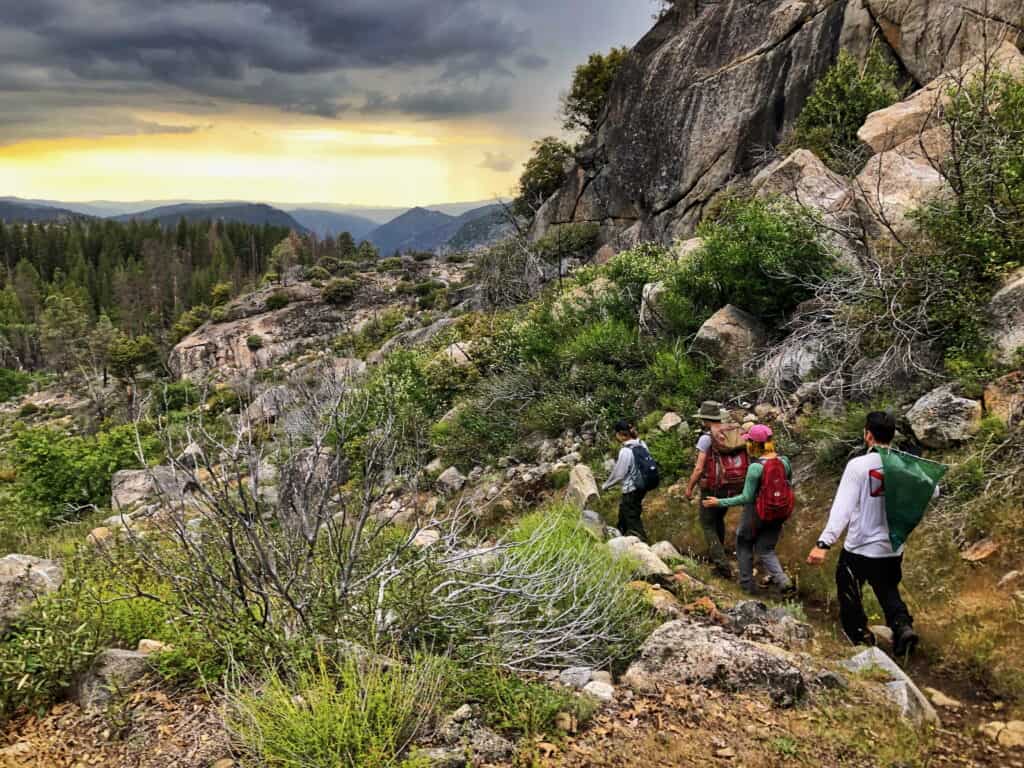In Yosemite National Park, invasive species removal helps native turtles just in time
After years of targeted bullfrog removal, juvenile pond turtles returned to two ponds in Yosemite National Park.
“We didn’t expect to see those first turtles pop up so fast,” said Sidney Woodruff, a doctoral student at the University of California, Davis. “It was really exciting.”
American bullfrogs (Lithobates catesbianus) are native to the eastern U.S., but people brought them around the world to farm. In the mid-1970s, people deliberately introduced them to the Hetch Hetchy Reservoir region of the park, although the reason remains unclear.

The frogs are voracious eaters, swallowing everything from small birds to other amphibians. They also eat hatchling northwestern pond turtles (Actinemys marmorata)—the slow-growing species takes about three years to get larger than a bullfrog’s mouth. These turtles, which are found from central California up to Washington with isolated populations in Nevada, are declining in numbers due to bullfrog predation, habitat loss, drought and pollution. They are currently under proposal for listing under the U.S. Endangered Species Act.
Remote frog removal
In order to restore the ecosystem and study the link between bullfrogs and pond turtles, wildlife managers began removing frogs from two sites in Yosemite’s Hetch Hetchy Reservoir region. They examined each frog’s stomach and continually monitored the pond turtle populations, publishing their results in a new study in Biological Conservation.

From 2015 to 2022, Woodruff and their teams hiked seven miles out to the remote ponds with their food and gear, staying in the backcountry for about a week at a time. They captured, euthanized and collected data on bullfrogs from around 9 p.m. to 4 a.m., when the frogs were most active, focusing their efforts on the shore and within about a foot of water. Sometimes, they took small rafts out to the middle of the ponds to access hard-to-reach areas or small islands where the frogs would hide. “I’m from Georgia, where bullfrogs are native to, and I love hearing that call,” Woodruff said. “Ultimately, it’s not the bullfrogs’ fault [that they’re here]; it’s ours.”
The team removed over 12,000 bullfrogs, larvae and egg masses from one pond and around 4,000 from another.
They also monitored the turtle population using a mark-recapture survey and modified foldable crab traps baited with mackerel at the two ponds where they removed bullfrogs, as well as another two that had no bullfrogs.
Quick results
Before eradication, the armies of invasive American bullfrogs at these two sites ate juvenile pond turtles. Although an aging population of adult turtles remained, the only evidence of juvenile northwestern pond turtles that researchers could find in the early days of their project was in the bellies of the frogs. At one of the ponds, the adult pond turtle population was as low as 30 individuals. The sites without bullfrogs, which were either ponds of the same size or even smaller, had around 300 turtles.

At the bullfrog ponds, turtles were 26-36% larger and 76-97% heavier than at the bullfrog-free ponds. Turtle abundance and densities were also two to 100 times higher at bullfrog-free ponds compared to bullfrog ponds.
In the nick of time
It wasn’t until 2019—four years into their study, when researchers had nearly eradicated the amphibians—that the researchers first found a juvenile pond turtle that wasn’t a frog meal. More juveniles began to turn up in their traps.
“We fully believe those would have been turtles that would have been gobbled up by a bullfrog,” Woodruff said.
Baby pond turtles face a host of challenges beyond bullfrogs. From land, raccoons (Prycon lotor), foxes, and skunks dig up nests and feast on their nests. Then, as hatchlings make their way to the water, birds like ravens (Corvus corax) will attack from the air. Largemouth bass (Micropterus nigricans), another introduced species, waits for them under the water. But if they are lucky enough to survive all these challenges and outgrow the mouth of a bullfrog, which takes about three years, Woodruff said their survival is high—around 97%.

Although turtles can live for decades, they take about eight to 12 years to reach reproductive age and only lay around six to 10 eggs per year. So, the adults that survived the bullfrog invasion were unable to produce any young that could grow to reproductive age to sustain the population. Woodruff believes this population was on the brink of disaster before researchers intervened.
Preserving California’s turtle diversity
The northwestern pond turtle is one of California’s two native freshwater turtles, the other being the southwestern pond turtle (A. pallida), which was recently separated as a distinct species. Northwestern pond turtles have been lost in around 80% of their range because of climate change, pollution, habitat loss, invasive species and drought, but places like national parks can offer safe havens.
Woodruff emphasized that inconsistent and haphazard invasive species removal efforts can cause population rebounds and make things even worse than before and that prevention is a more cost-effective and efficient method than eradication. But this intervention worked because of consistent funding from both nonprofit and federal partners—the latter of which was recently terminated—and a “unique set of circumstances that came together.” Those circumstances include ponds being isolated from visitors, the bullfrogs being intentionally introduced and isolated from other bullfrog populations, and researchers being able to dedicate lots of time and funding to total eradication.





